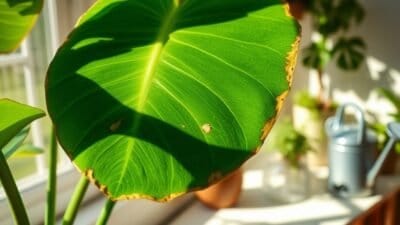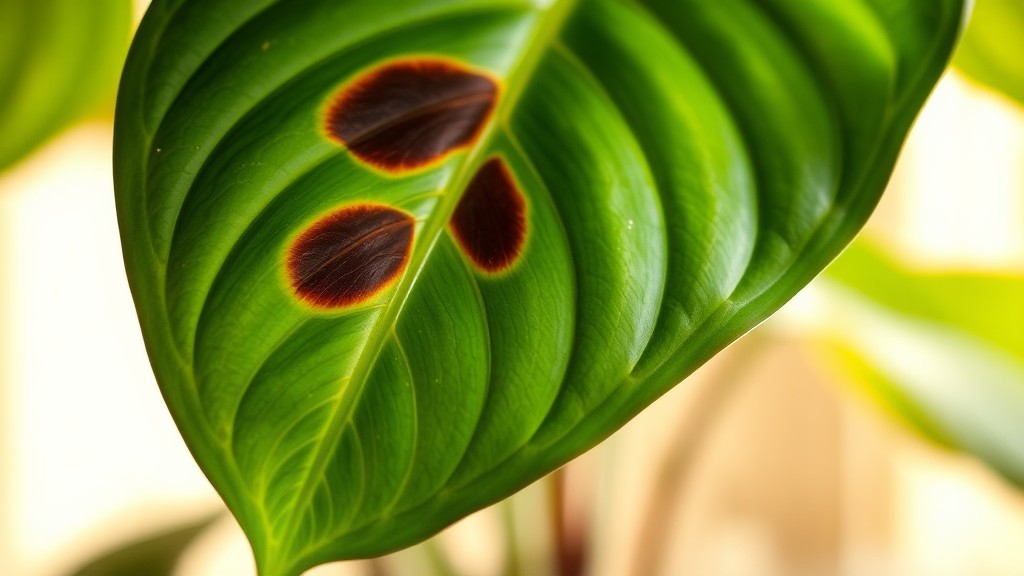Philodendron plants are cherished for their lush leaves and low-maintenance care. However, discovering brown spots on their leaves can be alarming for any plant parent. These spots may signal several underlying issues that require attention to keep the plant healthy.
Understanding the reasons behind the brown spots is essential for taking the right steps to restore your philodendron’s health. Factors such as overwatering, underwatering, or pest problems could be the cause. Want to learn more about the causes of these pesky brown spots and how to fix them? Keep reading for helpful solutions!
Key Takeaway
- Brown spots on philodendron leaves can result from overwatering, underwatering, or low humidity.
- Proper watering practices and humidity levels are key to preventing brown spots.
- Regularly checking for pests and diseases helps maintain the health of your indoor plants.
Common Causes of Brown Spots
Philodendron leaves may develop brown spot due to several factors. Understanding these causes can help maintain your plant’s health.
1. Overwatering
Credits: Legends Of Monstera
Overwatering is a common cause of brown spots on philodendron leaves. Excessively wet soil can lead to root rot, making leaves feel mushy and causing yellowing. To prevent this, ensure your pot has adequate drainage holes and regularly check soil moisture. Allow the top inch of soil to dry out before watering again. This practice helps prevent root rot and promotes strong root development, allowing the plant to absorb nutrients effectively.(1)
2. Underwatering

Underwatering can also cause brown spots on philodendron leaves. When the plant lacks moisture, the leaves may become crispy and develop lighter brown spots, indicating stress. To prevent this, regularly check soil moisture and water when the top inch feels dry. Establishing a consistent watering routine will help your philodendron thrive and stay vibrant. By monitoring these common causes, anyone can take steps to keep their philodendron healthy!
3. Low Humidity
Philodendrons thrive in humid environments, as they naturally grow in tropical regions with high humidity. When humidity drops, leaves can develop brown edges and spots, signaling that the plant lacks moisture. This can make the plant more susceptible to stress. To increase humidity, consider using a humidifier or placing a pebble tray filled with water near your plant. As the water evaporates, it raises humidity levels, creating a better environment for your philodendron. Maintaining humidity between 60-80% is ideal for its health and vibrancy. By addressing low humidity, plant owners can help ensure their philodendrons remain lush and thriving!
4. Sunburn
Direct sunlight can scorch philodendron leaves, leading to flat, smooth brown spots. These spots indicate excessive light exposure, which can damage the leaves and hinder growth. To prevent sunburn, place your plant in bright but indirect light. An ideal spot is near a window with filtered light or one that receives morning sun but is shaded in the afternoon. By managing humidity and light exposure, anyone can keep their philodendron healthy and beautiful!
5. Nutrient Deficiencies
Brown spots on philodendron leaves can arise from a lack of essential nutrients, such as calcium and magnesium. When these nutrients are deficient, the plant may struggle to grow, leading to discolored leaves and stunted development.
To prevent nutrient deficiencies, it is important to fertilize your philodendron regularly during the growing season. Using a balanced liquid fertilizer can help maintain proper nutrient levels in the soil, ensuring that your plant receives the necessary elements for healthy growth. A well-nourished plant is less likely to exhibit signs of stress, helping to keep those brown spots at bay.
6. Fungal Infections
Fungal infections, such as leaf spot disease, manifest as dark brown spots with yellow halos around them. These infections often occur due to overwatering or inadequate air circulation, which creates a damp environment conducive to fungal growth.
If you notice signs of a fungal infection, it is crucial to act quickly by removing the infected leaves to prevent further spread. Following this, treat the plant with a suitable fungicide to address the issue effectively. Additionally, improving air circulation and adjusting your watering practices can help maintain a healthy environment for your philodendron, reducing the risk of fungal infections.
By understanding these causes, plant owners can take proactive measures to keep their philodendrons healthy and vibrant!
7. Pest Infestations
Pests, such as spider mites, can lead to the development of brown spots on philodendron leaves. These tiny pests can cause significant damage to the plant if not addressed promptly. Regular inspections are essential for catching any infestations early, allowing for effective intervention before serious harm occurs.
If pests are discovered, it is important to treat them quickly using appropriate insecticides or natural remedies like neem oil. These treatments can help eliminate the pests and protect the plant from further damage. Additionally, keeping the leaves clean by gently wiping them with a damp cloth can help deter pests and promote overall plant health.
By staying vigilant and proactive in monitoring for pests, anyone can help ensure their philodendron remains healthy and thriving!
Solutions and Preventive Measures
To effectively manage brown spots on your philodendron, consider implementing these solutions:(2)
- Watering Practices: Establish a consistent watering schedule that allows the soil to dry out slightly between waterings. This approach helps avoid the pitfalls of both overwatering and underwatering, promoting a healthier environment for your plant.
- Soil Quality: Use fresh, well-draining soil to ensure proper drainage. This prevents water from pooling around the roots, which is essential for maintaining healthy roots and leaves. A quality potting mix can significantly enhance your plant’s well-being.
- Light Conditions: Position your philodendron in an area that receives bright, indirect light. This placement helps prevent sunburn while ensuring the plant receives sufficient light for optimal growth. Adjusting the location based on seasonal changes can also be beneficial.
- Humidity Levels: Increase humidity around your plant by using humidifiers or placing pebble trays filled with water nearby. Maintaining high humidity levels can help prevent brown spots caused by dry air, creating a more suitable environment for your philodendron.
- Regular Maintenance: Regularly prune any affected leaves and monitor your plant for pests or signs of disease. Keeping a close eye on your philodendron allows for early detection of issues, making it easier to address them before they escalate.
By incorporating these solutions and preventive measures, anyone can effectively manage brown spots and ensure their philodendron remains healthy and vibrant!
Monitoring Your Plant
Regularly observing your philodendron is essential for maintaining its health. Look for signs such as brown spots, yellowing leaves, or the presence of pests. If any changes are detected, it’s important to take action promptly to prevent further complications.
Consider moving your plant to a more suitable location if it is not receiving adequate light or if it is exposed to harsh conditions. Adjusting your watering routine based on the moisture level of the soil can also make a significant difference in the plant’s overall health.
Conducting regular checks will help ensure your philodendron remains vibrant and thriving. By staying attentive to its needs, anyone can support their plant’s growth and well-being!
Conclusion
Conclusion
Brown spots on your philodendron can arise from various factors, including overwatering, underwatering, and low humidity. Understanding these causes is crucial for maintaining the health of your plant. By implementing targeted care strategies, such as adjusting watering practices and enhancing humidity levels, you can effectively manage and prevent these issues.
Consistent attention to your philodendron’s needs will ensure it remains vibrant and healthy. Making small adjustments to its care routine can lead to significant improvements in its overall well-being. With diligent care, anyone can enjoy a thriving philodendron that adds beauty to their living space. This proactive approach fosters a rewarding experience for plant owners.
FAQ
What causes brown spots on philodendron leaves, and how can I treat them?
Brown spots on philodendron leaves can be caused by several factors, including fungal infections or bacterial leaf spot. To treat these issues, you might consider using neem oil as a natural remedy. Additionally, ensure that your plant’s roots are healthy and that you are not overwatering, which can lead to root rot and brown dry spots on leaves.
Why are my philodendron leaves turning yellow or brown?
If you notice yellow or brown leaves on your philodendron, it could be due to low humidity or excess water. Check the soil moisture and make sure the drainage holes are not clogged. Adjusting your watering practices and increasing humidity levels can help restore healthy leaves and prevent further yellowing of leaves.
How does direct sunlight affect my philodendron’s health?
Direct sunlight can harm your philodendron, causing leaves to turn yellow or develop rust spots. It’s best to place your plant in indirect light to maintain its vibrant green color and prevent leaf spot disease. If you notice brown edges or spots on leaves, consider moving your plant to a location with better air circulation and appropriate light conditions.
What should I do if my philodendron has white dots on its leaves?
White dots on your philodendron’s leaves may indicate an infestation of spider mites. To combat this issue, increase humidity around the plant and regularly check for infected leaves. Using neem oil can also help eliminate these pests while promoting healthy growth during the growing season.
How can I improve drainage for my philodendron?
To improve drainage for your philodendron, use fresh soil that allows for better water retention without causing root rot. Ensure that the pot has adequate drainage holes to prevent excess water accumulation. This will help keep your plant’s roots healthy and reduce the chances of brown spots or leaf spot diseases developing.
References
- https://greg.app/brown-spots-on-split-leaf-philodendron-leaves/
- https://chaletboutique.com.au/blogs/greenery-care-hub/brown-dots-philodendron?
Related Article
- https://knowngarden.com/brown-spots-on-philodendron-birkin/
- https://www.gardeningknowhow.com/philodendron/brown-philodendron-leaves.htm
- https://knowngarden.com/brown-spots-on-houseplant-leaves/

